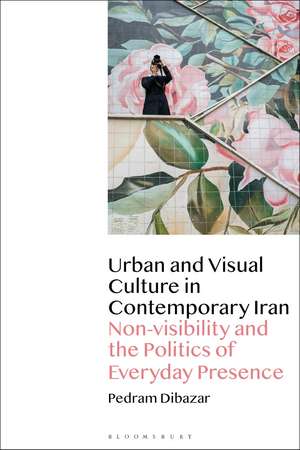Urban and Visual Culture in Contemporary Iran: Non-visibility and the Politics of Everyday Presence
Autor Pedram Dibazaren Limba Engleză Paperback – 19 oct 2022
Preț: 197.42 lei
Nou
Puncte Express: 296
Preț estimativ în valută:
37.78€ • 41.16$ • 31.83£
37.78€ • 41.16$ • 31.83£
Carte tipărită la comandă
Livrare economică 23 aprilie-07 mai
Preluare comenzi: 021 569.72.76
Specificații
ISBN-13: 9781350243255
ISBN-10: 1350243256
Pagini: 224
Ilustrații: 8 colour and 32 bw illus
Dimensiuni: 156 x 234 x 16 mm
Greutate: 0.32 kg
Editura: Bloomsbury Publishing
Colecția Bloomsbury Visual Arts
Locul publicării:London, United Kingdom
ISBN-10: 1350243256
Pagini: 224
Ilustrații: 8 colour and 32 bw illus
Dimensiuni: 156 x 234 x 16 mm
Greutate: 0.32 kg
Editura: Bloomsbury Publishing
Colecția Bloomsbury Visual Arts
Locul publicării:London, United Kingdom
Caracteristici
Provides creative cross-disciplinary analysis of contemporary Iranian society and its culture of urban mobility
Notă biografică
Pedram Dibazar is a lecturer in the Humanities at Amsterdam University College and a researcher at Amsterdam School for Cultural Analysis at the University of Amsterdam, The Netherlands.
Cuprins
List of PlatesList of FiguresAcknowledgementsIntroduction1 STREETSCapturing the non-visibility of everyday presenceUrban emptinessAbsent presenceAn orientation towards the everyday2 CARSInhabiting the everyday, enacting an embodied cinema of mobilityOn the move: Abbas Kiarostami's wandering cars and extendedpresenceDwelling in mobilityMobilizing the lookAn embodied cinema of everyday interactionConclusion3 ROOFTOPSThe invisibility and ambiguity of leftover spaceRooftops and the everyday cityRooftops of Iran: Memoirs and popular cultureOn leftover spaceUrban rooftops in Iran: The ambivalence of leftover spaceRooftop protests: The everyday practice of shouting from rooftopsConclusion4 SHOPPING CENTRESThe ambivalence of the scopic regime of the strollAmbiguities of the shopping centreThe scopic regimes of shoppingGoing for a walk in the shopping centreConclusion5 SPORTSThe unrelenting visibility of wayward bodiesSports and everyday life in Iran: A short historyGeographies and visualities of sportThe hypervisibility of television sportsThe spectral community of television sports spectatorsConclusionConclusionWorks CitedIndex
Recenzii
How do people experience cities and media in their everyday lives? How do they navigate their challenges and opportunities? Pedram Dibazar's book offers a refreshing take on the modalities of experiencing the urban and visual space in Iran-in its streets, cars, rooftops, shopping centres and sportscapes. Urban and Visual Culture in Contemporary Iran is a welcome contribution to the study of cities and their citizens as they operate in the subtleties of the quotidian.
From the humdrum to the carnevalesque and the subversive, Dibazar exposes how power, social practice and unruly creativity tie together the spatial and visual domains of everyday life in urban Iran, providing us with sophisticated insights into how people, places and things come together as society.
This innovative study of urban Iran and visual culture offers powerful, new insights into the politics of visibility in cities. Dibazar develops a sophisticated theoretical framework through which to interpret architecture, film, media and everyday spatial practices. The result is not only a highly original analysis of contemporary Tehran, but also a conceptual toolkit for understanding the experience of cities everywhere.
From the humdrum to the carnevalesque and the subversive, Dibazar exposes how power, social practice and unruly creativity tie together the spatial and visual domains of everyday life in urban Iran, providing us with sophisticated insights into how people, places and things come together as society.
This innovative study of urban Iran and visual culture offers powerful, new insights into the politics of visibility in cities. Dibazar develops a sophisticated theoretical framework through which to interpret architecture, film, media and everyday spatial practices. The result is not only a highly original analysis of contemporary Tehran, but also a conceptual toolkit for understanding the experience of cities everywhere.
